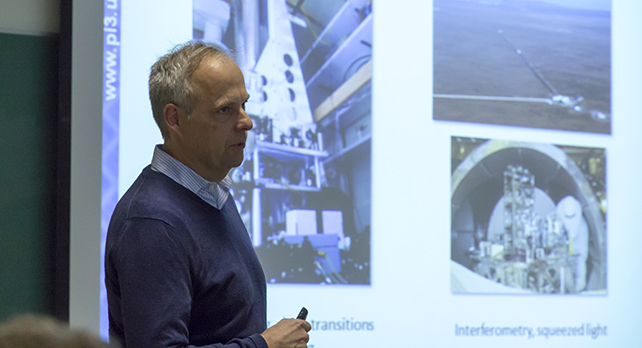

Workshops & Schools
Workshops & Schools - Overview

From Quantum Matter to Quantum Information
Speaker: See program
Date & Time: June 24 - 27, 2013
Location: UBC, MacLeod 202
Local Contact: Robert Raussendorf
Intended Audience: Graduate
June 24 – 27, 2013, University of British Columbia
The workshop “From Quantum Matter to Quantum Information” took place between June, 24th and June, 27th, 2013. With about 60 participants from academia and industry, coming to UBC from 7 countries, the workshop allowed to discuss present developments in the field of quantum matter and quantum information. 23 presentations were selected to cover a wide range of theoretical and experimental approaches towards quantum information science. A special focus was given to approaches and techniques with a strong link to quantum materials. A number of speakers from the Max Planck Society in Germany were selected to recognize their strength in the covered fields and to link their work to the existing collaboration of MPG and UBC.
To allow for a lively workshop, undergraduates and graduate students were specially invited to submit their work as presentations or posters. A little less than the half of the participants were at the graduate student level or below. About 25 posters were presented.
The workshop was strongly interdisciplinary. The fields of ‘ultra-pure matter’ and ‘superconductivity’, as ‘classic’ fields in the domain of solid state research were covered: Mike Thewalt (SFU, Canada) and Andrea Morello (UNSW, Australia) introduced ultra-pure Silicon structures and their application for coherent and quantum phenomena. Superconducting structures were discussed e.g. by Rogerio de Sousa (UVIC, Canada), David Herrera Marti (NUS, Singapore), Jay Gambetta (IBM Research, USA), and Mark Johnson (D-Wave, Canada). A very interdisciplinary talk the presentation of Alexandre Blais (Sherbrook, Canada) linked a variety of experiments of the present research in photonic light-matter interaction to experiments with superconducting resonators. This was a strong link to other speakers, covering coherent phenomena in photonics, such as Vahid Sandoghdar (MPI for the science of light, Germany), and Yu-Au Chen (USTC, China). The control of single spins, such as the nitrogen-vacancy center in diamond was discussed by Jörg Wrachtrup (MPI for Solid State Research, Germany), Gopalakrishnan Balasubramaniam (MPI for Biophysical Chemistry, Germany), Osama Moussa (IQC, Canada) and Andrew Golter (University of Oregon, USA). Atomic qubits were introduced by Christian Gross (MPI for Quantum Optics, Germany). A number of theoretical approaches were introduced e.g. by Jens Eisert (FU Berlin, Germany), Herrmann Kampermann (University of Dusseldorf, Germany), and Michael Zwerger (University of Innsbruck, Austria).
New collaborations of UBC and MPG members were planned and are presently under realization: Vahid Sandoghdar (MPI for the Science of Light, Erlangen, Germany) and Takamasa Momose (Physics and Astronomy, UBC, Canada) started a new collaboration towards single emitter detection in the solid state. Ilja Gerhardt (MPI for Solid State Research, Germany) extended his link to the UBC Chemistry department for an upcoming project in 2014.
The workshop was organized and planned by Robert Raussendorf (UBC), Takamasa Momose (UBC), Ilya Efimov (UBC), Joshua Folk (UBC), Jeff Young (UBC), Yan Pennec (UBC), George Sawatzky (UBC) and Ilja Gerhardt (MPI for Solid State Research, Stuttgart). The logistic organization was arranged by Maria Pylaeva.